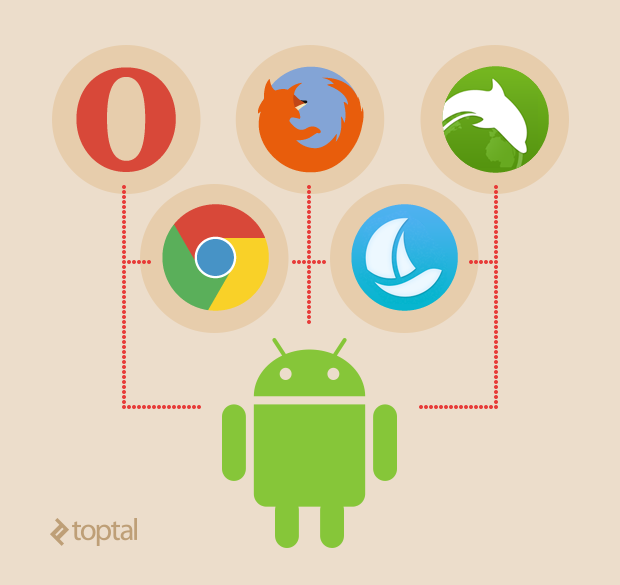There are 6.8 billion people on the planet, 5.1 billion of whom own a cell phone. And today, an ever-growing percentage of these devices are smartphones.
BY Tomas Agrimbau
SOFTWARE ENGINEER @ TOPTAL
According to a recent Pew Research Center Study, the number of users accessing the Internet on their smartphones has more than doubled in the past 5 years, as has the number of users downloading and using mobile apps. Of those who use the Internet or email on their phones, more than a third go online primarily through their handheld devices. Indeed, mobile computing is becoming increasingly ubiquitous… And it’s awesome. Except, of course, when it’s not.
As a mobile device user, few things are as frustrating and difficult to fat-finger-navigate as a poorly designed mobile web or native app.
And as a mobile app developer, few things can be as intensely irritating as striving to support as wide a range of mobile clients as possible, each of which has its own frustrating set of idiosyncrasies. Whether you choose to develop a mobile web, native, or hybrid app, the quest to support multiple mobile browsers, more-exotic devices, and platforms can be quite a gut wrenching experience indeed.
 As a mobile device user, few things are as frustrating and difficult to fat-finger-navigate as a poorly designed mobile web or native app. And as a mobile app developer, few things can be as intensely irritating as striving to support as wide a range of mobile clients as possible, each of which has its own frustrating set of idiosyncrasies.
As a mobile device user, few things are as frustrating and difficult to fat-finger-navigate as a poorly designed mobile web or native app. And as a mobile app developer, few things can be as intensely irritating as striving to support as wide a range of mobile clients as possible, each of which has its own frustrating set of idiosyncrasies.
Of course, not every developer today needs to worry about supporting mobile clients. But the increasingly omnipresent nature of mobile devices and applications strongly suggests that those who don’t need to support mobile clients today will more than likely need to do so in the not-too-distant future. So if you’re not already thinking about mobile app development, you probably should be.
Mobile app: Web vs. native vs. hybrid (help me choose!)
As is true with most technology selections, there’s no one-size-fits-all answer when it comes to the type of mobile app to develop. There are numerous web app best practices to consider, not all of which are technical. Who is your target audience? Are they more likely to prefer a mobile web or a native app? What development resources do you have and which mobile technologies are they most familiar with? What is the licensing and sales model that you’re envisioning for your product?
Generally speaking (although there are always exceptions), the mobile web route is faster and cheaper than the native app route, especially when the objective is to support a wide range of devices. Conversely, there may be capabilities native to the mobile device (such as the movement sensor and so on) that are essential to your app, but which are only accessible via a native app (which would therefore make the mobile web app choice a non-starter for you).
And beyond the web vs. native question, a hybrid app may be the right answer for you, depending on your requirements and resource constraints. Hybrid apps, like native apps, run on the device itself (as opposed to inside a browser), but are written with web technologies (HTML5, CSS and JavaScript). More specifically, hybrid apps run inside a native container, and leverage the device’s browser engine (but not the browser) to render the HTML and process the JavaScript locally. A web-to-native abstraction layer enables access to device capabilities that are not accessible in mobile web applications, such as the accelerometer, camera, and local storage.
But whatever choice you make – whether it be mobile web, native or hybrid app – be careful to adequately research and confirm your assumptions. As an example for the purposes of this mobile web app development tutorial, you may have decided to develop a native app for e-commerce to sell your products, but according to Hubspot, 73% of smartphone users say they use the mobile web more than native apps to do their shopping… so you may have bet on the wrong horse.
But whatever choice you make – whether it be mobile web, native or hybrid app – be careful to adequately research and confirm your assumptions.
And then, of course, there are the practical considerations of time and budget. As one of my favorite sayings goes, “faster, better, cheaper… pick any two”. While time-to-market and cost constraints are of paramount importance in web application development, it’s crucial not to compromise too heavily on quality in the process. It’s quite difficult to recover the confidence of a user who has had a bad first experience.
Indeed, mobile web, native, and hybrid apps are all radically different beasts, each with their own unique set of benefits and challenges. This development tutorial specifically focuses on methodologies and tools to employ, and pitfalls to avoid, in the development of highly functional, intuitive, and easy-to-use mobile web applications.
Identifying your (or your customer’s) requirements is one of the most essential best practices in app development, mobile or otherwise. Carefully research the targeted capabilities to determine if they are achievable in a web app. It’s quite frustrating, and highly unproductive, to realize that one or more of your essential client functions aren’t supported, when you’ve already invested the time and resources to design the web-based interface and supporting infrastructure.
Plan ahead (“if you don’t know where you’re going, you just might end up there…”)
Another common gotcha for mobile web app developer newbies is to ass-u-me that web-based code for a desktop browser will work “as is” in a mobile browser. Not. There most definitely are differences and, if you’re not aware of them, they can definitely bite you. The HTML5 <video> tag’s autoplay functionality, for example, doesn’t work on mobile browsers. Similarly, the CSS transition and opacity properties are not supported (or at least are not consistently supported) in most mobile browsers nowadays. You will also have problems with some web API methods on a mobile platform, such as the SoundCloud music streaming API that requires Adobe Flash which is not supported on most mobile devices.
A common gotcha for mobile web app developer newbies is to ass-u-me that web-based code for a desktop browser will work “as is” in a mobile browser.
A particularly complicating factor in mobile web application development is that the lifespan of mobile devices tends to be much shorter than that of desktop displays (the average lifespan of a cell phone in the U.S. is around 21 months). These shorter device life spans, accompanied by constant releases of new mobile devices and technologies, yield an ever-changing landscape of to-be-targeted devices. While working in a browser does somewhat alleviate this issue by shielding you from a number of device-specific issues, you will still need to design a browser-based view that supports many different screen resolutions (as well as adjusting appropriately for landscape and portrait orientations).
Thought needs to be given as well to supporting Apple’s Retina Displays (liquid crystal displays that have a pixel density high enough that the human eye is unable to discern individual pixels at a typical viewing distance). Several Apple products – including the iPhone, iPod Touch, iPad, MacBook Pro, iPad Mini, and iPad Air – offer Retina displays. For a mobile web app in particular, it’s important to be aware that a Retina display makes low resolution images (which are typically served to mobile devices) look fuzzy and pixelation can occur. The best app development solution in these cases is to have the server recognize that the request is coming from a Retina device and to then provide an alternate higher resolution image to the client.
If you want to use some of the cool HTML5 stuff, remember to verify in advance that the functionality you’re looking for is supported across the device landscape that your customers are likely to be using. For example, in iOS 6 and above, there is no support for the navigator getUserMedia functionality since the camera is only accessible through native apps. Two great resources for checking what’s supported on specific devices and browsers are caniuse.com and html5test.com.
Remember to verify in advance that the functionality you’re looking for is supported across the device landscape that your customers are likely to be using.
CSS3 media queries can also help you provide customized content for each device. Here’s some example code for capturing different device characteristics, such as pixel density, screen resolution, and orientation.
Performance, performance, performance
“OMG, this thing is sooooo slow!” As a mobile web app developer, those are probably the very last words you ever want to hear from one of your users. You must therefore think carefully about how to reduce and optimize each byte and server transfer to reduce the user’s wait time. It’s unrealistic to expect that transfers will always be done over a WiFi network, and you should know that 60% of mobile web users say they expect a site to load on their mobile phone in 3 seconds or less (source). Similarly, Google found that, for every extra 5 seconds of load time, traffic dropped by 20% (and it is also worth noting that search engines look at load times as part of their calculation of page quality score).
60% of mobile web users say they expect a site to load on their mobile phone in 3 seconds or less.
Wrap up
With the continued rapid expansion of the number, variety and sophistication of mobile devices on the market and in use today, the need for effective, user-friendly, high performance mobile applications is likely to increase substantially. Being able to develop these applications intelligently and efficiently will therefore continue to be of paramount importance.
Many factors must be considered when choosing between the web, native, and hybrid options for mobile applications. Each has its own advantages, but mobile web apps will often represent your most efficient development (and therefore time-to-market) option. Should you choose to go down that path, I hope this web app development tutorial helps get you more directly and successfully to your destination.
